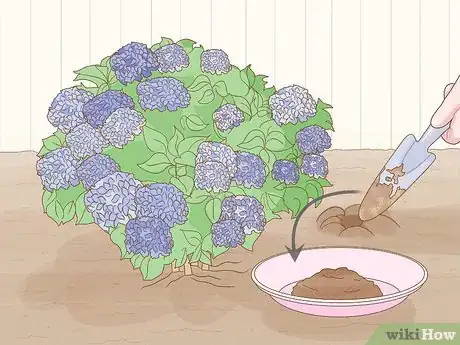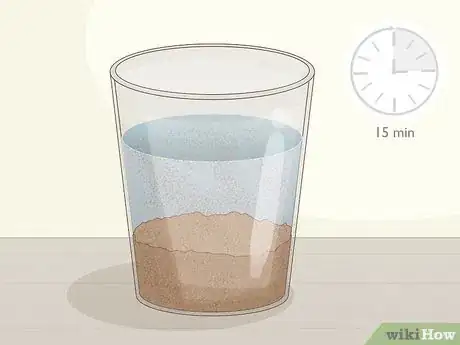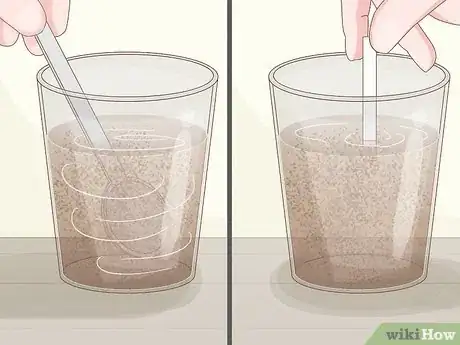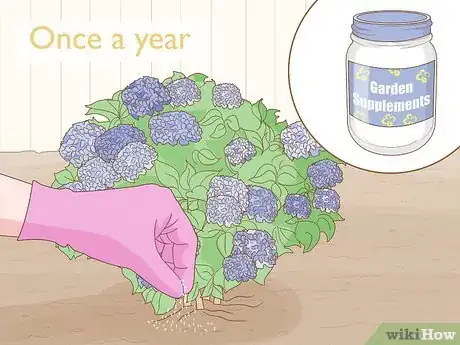This article was co-authored by wikiHow staff writer, Hannah Madden. Hannah Madden is a writer, editor, and artist currently living in Portland, Oregon. In 2018, she graduated from Portland State University with a B.S. in Environmental Studies. Hannah enjoys writing articles about conservation, sustainability, and eco-friendly products. When she isn’t writing, you can find Hannah working on hand embroidery projects and listening to music.
This article has been viewed 12,204 times.
Learn more...
Hydrangeas are large, shrub-like plants that produce huge, vibrant flowers every year. These plants are unique in that their flowers change color based on what type of soil they are in. If you are looking to turn your hydrangea flowers purple, you can change the pH of your soil over 1 to 2 growing seasons and slowly watch your flowers change color for beautiful purple blooms in the spring.
Steps
Testing the Soil pH
-
1Purchase a soil pH test. Soil pH kits come in a few different designs. Purchase a tester probe if you’d like a digital and reusable option that you can keep in your garden for whenever you need it. Or, buy a paper test kit or chemical test kit to use a color-coded key and stick with a cheaper option.[1]
- You can find soil pH kits at most garden supply stores or nurseries.
- Soil probes are the most accurate since they give a numerical reading instead of a color-coded key.
-
2Take a sample of soil from your hydrangeas. Scoop a small sample of soil from the area where your hydrangea roots are. Make sure there aren’t any rocks, twigs, or leaves mixed in with your soil, or it could throw off your test results.[2]Advertisement
-
3Mix the soil with water in a 1:1 ratio. Place your scoop of soil into a container and add about as much water as there is soil. Mix your soil and water together for 5 to 10 seconds until they create a muddy paste.[3]
- If you are using a chemical dye pH tester, don’t mix your soil with water. Instead, mix it with the solution that comes in the kit.
-
4Let the mixture sit for 15 minutes. Allow any sediment or large pieces of dirt fall to the bottom of your mixture. Leave your container on a flat surface where it won’t be disturbed.[4]
- Don’t place your container directly in the sun, or it could heat up your sample and skew the results.
-
5Stir up the soil and then dip your tester into it. Use your testing stick or a spoon to mix up your sample again and then dip your probe or paper strip into the mixture. Hold your tester in the sample for 5 to 10 seconds until your probe gives you a numerical result or your strip turns a different color.
-
6Compare the test strip color to the key if you are using a paper tester. Hold your paper test strip next to the pH code. Compare the color from the test strip and match it to a color on the key to assign a numerical value to your soil.[5]
Tip: Even if your test strip doesn’t match up perfectly with a specific pH value, you can get an estimation of where your soil pH is.
Raising or Lowering the Soil pH
-
1Aim for a pH between 5.5 and 6.5. If your soil pH is below 5.5, it is probably too acidic for purple hydrangeas and may be producing blue flowers. If the soil pH is above 6.5, it is too basic for purple flowers and might be giving you pink or red ones. For purple hydrangeas, aim for a more neutral pH between 5.5 and 6.5.[6]
-
2Add aluminum sulfate to your soil to lower the pH. If your soil is higher than 6.5, mix 1 tbsp (15 g) of aluminum sulfate with 1 gallon (3.8 L) of water in a bucket. Pour the water around the roots of your plant and make sure the soil absorbs all of it.[7]
- You can find aluminum sulfate at most garden supply stores.
- If your hydrangea is already red, it will be much easier to get it to a purple stage.
-
3Use ground lyme to raise your pH. Mix 1 cup (64 g) of lyme with 1 tablespoon (15 mL) of water. Pour the lyme mixture around the roots of your hydrangea to raise the pH of your soil.[8]
- Lyme makes it harder for your hydrangea plant to absorb aluminum so it will become more purple.
Warning: Always use gardening gloves when handling lyme to protect your skin from irritation.
-
4Keep adding garden supplements once a year until your hydrangeas are purple. It may take a long time for your flowers to change color, since hydrangeas absorb nutrients slowly. Add the lyme or the aluminum sulfur once a year during the fall so your plants can absorb them over the winter and change color before spring.[9]
- Adding too much of your supplement at a time could harm your plants in the long run. It’s better to add them slowly over time to preserve the health of your hydrangeas.
- It can take 1 to 2 growing seasons for your hydrangeas to change color.
-
5Test your soil pH again to see if it has changed. If you aren’t getting the results that you want, use a second soil pH tester kit to sample your soil again about 1 year after putting your supplements in. If your soil pH is still too acidic or basic, keep adding your supplements. If your soil pH has reached a neutral area between 5.5 and 6.5 and your flowers still aren’t purple, you may not have the right starting color to reach your goal.[10]
- Red hydrangeas are much easier to change to purple since they mix with a blue color. Blue hydrangeas are harder to change to purple since they are already on the blue area of the color wheel.
- Although you can change the color of your hydrangeas, you can’t change the vibrancy of the color.
Things You’ll Need
- Soil pH tester (probe or paper strip)
- Aluminum sulfur or garden lyme
Warnings
- Always wear gloves when handling garden lyme to avoid skin irritation.⧼thumbs_response⧽
References
- ↑ https://extension.oregonstate.edu/measuring-soil-ph
- ↑ https://extension.oregonstate.edu/measuring-soil-ph
- ↑ https://efotg.sc.egov.usda.gov/references/public/WI/Soil_Quality_Test_Kit_Guide.pdf
- ↑ https://efotg.sc.egov.usda.gov/references/public/WI/Soil_Quality_Test_Kit_Guide.pdf
- ↑ https://extension.oregonstate.edu/measuring-soil-ph
- ↑ https://www.youtube.com/watch?v=M2ci_B4I8-8&feature=youtu.be&t=67
- ↑ https://www.youtube.com/watch?v=M2ci_B4I8-8&feature=youtu.be&t=114
- ↑ https://www.youtube.com/watch?v=M2ci_B4I8-8&feature=youtu.be&t=158
- ↑ https://www.americanscientist.org/article/curious-chemistry-guides-hydrangea-colors






































































